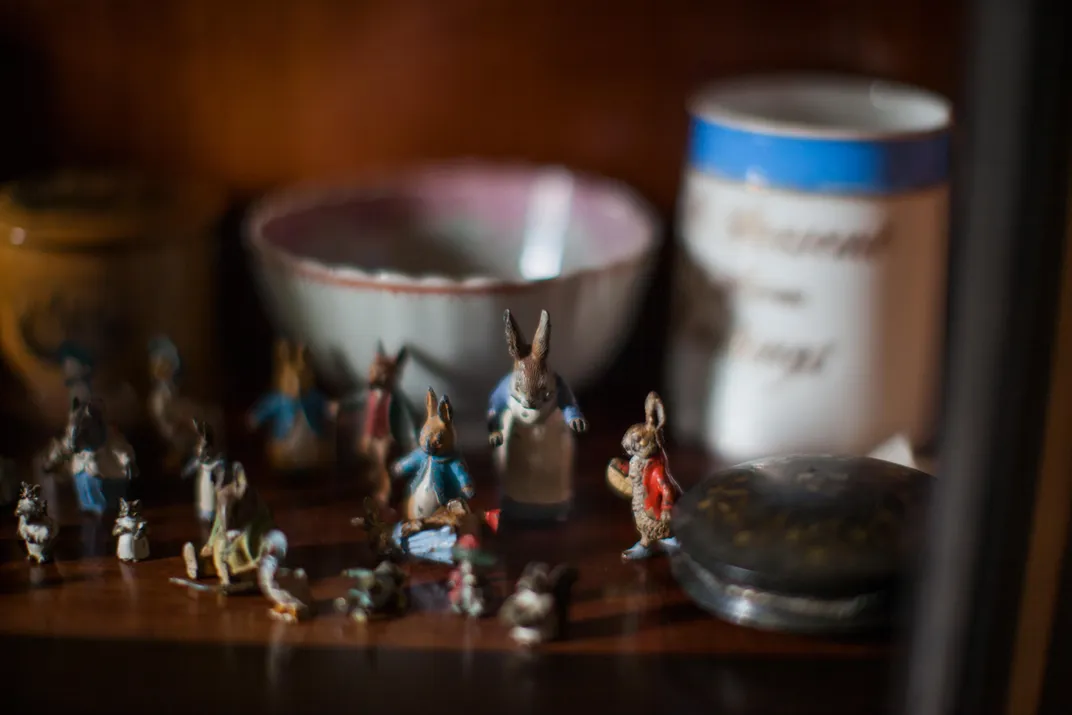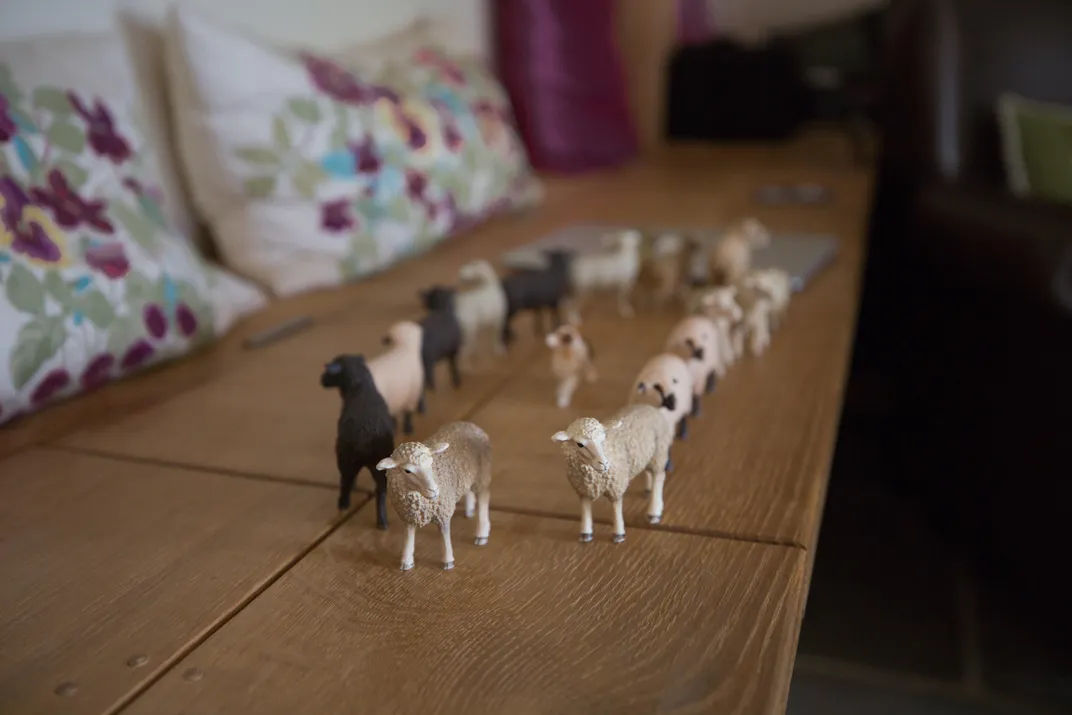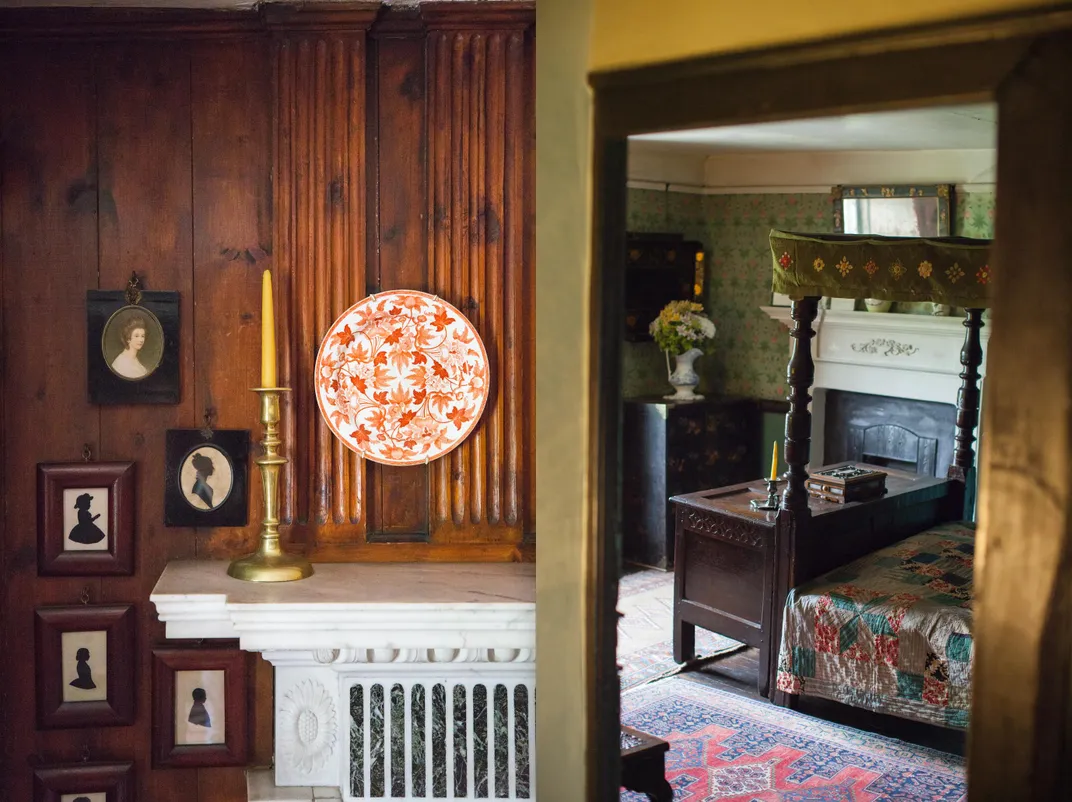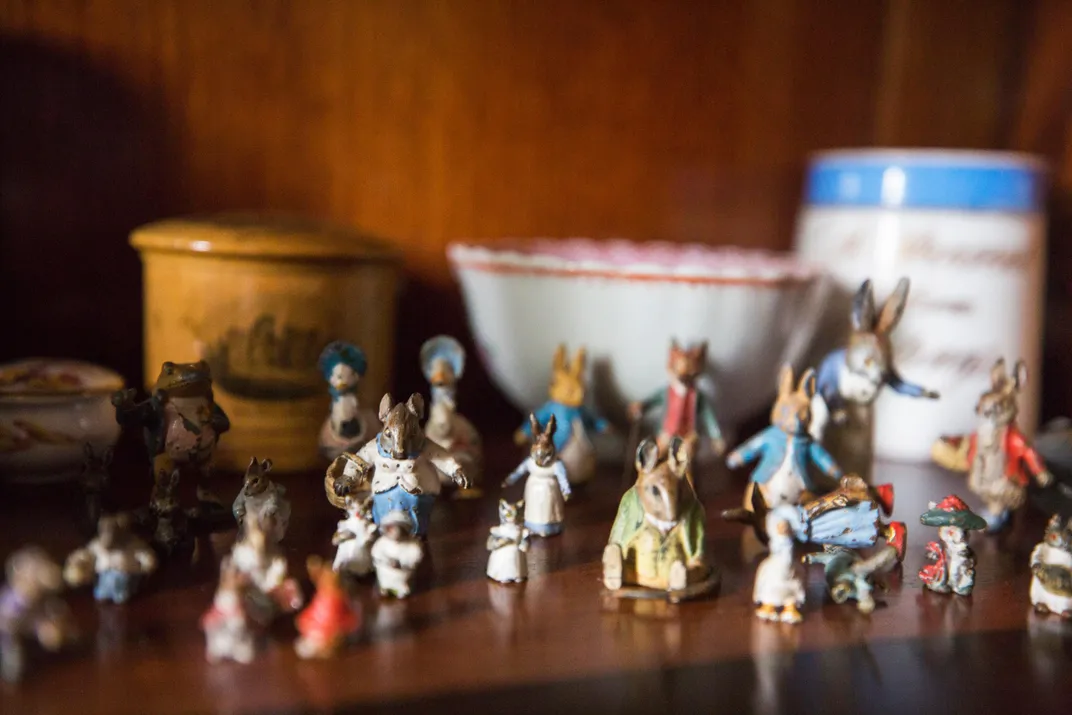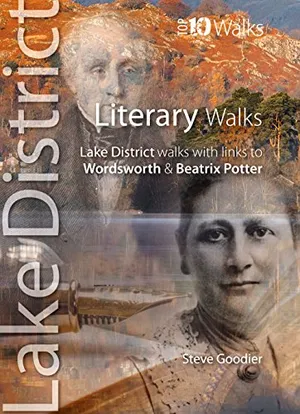The books of Beatrix Potter will endure as long as there are children. Masterpieces of humor and shrewd economy, her tales of bunnies and badgers and frogs in breeches explore the interplay of wild and domestic worlds. “She wrote most of them at a time when nature was viewed as something of little value, when the plunder of nature was more popular than its preservation,” observed biographer Linda Lear in Beatrix Potter: A Life in Nature. The lively stories of this native Londoner re-established the outdoors in the British imagination.
Potter’s writing retreat in northwest England, in the Lake District of Cumbria, is neither a lily pad nor a hollow log. Instead, Hill Top—the home she bought in 1905 largely with royalties from her little books—is a hulking stone structure of tiny, dark rooms: cozy on a rainy day, but lacking the airy charm of her watercolors. On a recent afternoon, two Australian tourists sprinted past the oak settles, the coffin stools and me faster than you can say Jemima Puddle-Duck. As they reached the exit, one chirped brightly: “Well, it’s better than Shakespeare’s house. That place was really dreary.”
Potter described the surroundings, including the village of Near Sawrey, as “nearly perfect a little place as I ever lived in.”
Gaze out the window of her study and you’ll see a field of sheep, quite possibly descendants of the flocks she kept on her 14 Lakeland farms. Potter was crazy about sheep, particularly the Herdwick, a local breed of Norse pedigree that roams freely in the Lake District, grazing on one of the most intact remaining common land systems in Europe. It was while on a family vacation in the Lake District that young Beatrix fell in love with Herdies and their comical faces, white heads and feet, and distinctive shocks of gray wool. As an adult, she and her shepherd, Tom Storey, amassed a herd of more than a thousand, which won a drawerful of rosettes at local shows. In 1943, Potter was voted president-elect of the Herdwick Sheep Breeders Association—the first woman named to the post— though she died before she was able to take office.
/https://tf-cmsv2-smithsonianmag-media.s3.amazonaws.com/filer_public/10/be/10be1422-e3c8-459f-8daa-fa35248661cc/may2018_g04_lakedistrict.jpg)
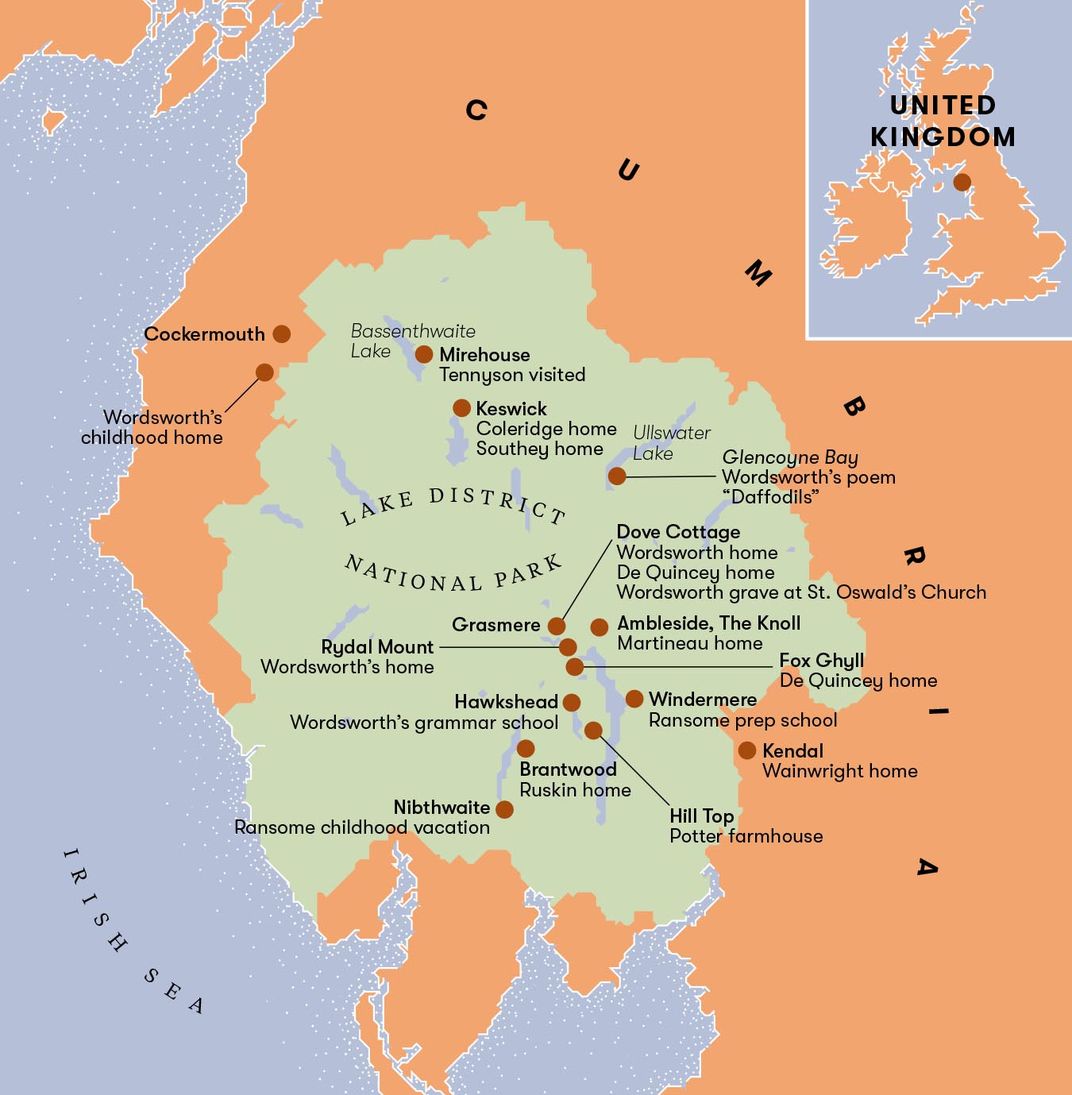
Potter worked tirelessly to maintain the ecology and distinct farming culture of Lakeland, where native son William Wordsworth “wandered lonely as a cloud” among his daffodils. She bought up tranches of farmland to save them from development, and helped preserve the tradition of using the highlands for common grazing—a practice that prompted Wordsworth to describe the region as a “perfect republic of shepherds” who “exhibited a perfect equality.” Potter left more than 4,000 acres (including Hill Top) to the National Trust, a charity that conserves historic places and spaces.
In 1951, some 885 square miles of Cumbrian hills and tarns (mountain pools) were designated as a national park, Britain’s largest and, with 18 million annual visitors, its most popular. But the prosperity brought by tourism has not extended to the hill farms. Upland agriculture is in crisis. Already stretched shepherds face pressure to reduce stock numbers; income is drying up; tourists price locals out of the housing market; Herdwick wool, though impervious to rain and wind, is scratchy and uncomfortable; and the heathery Herdwick meat, featured on the menu for the 1953 coronation of Queen Elizabeth II and known as the “Royal Mutton,” is too pricey for most; cheaper, less seasonal New Zealand imports offer stiff competition.
With hilltop farms in trouble, Potter’s wondrous arcadian refuge is increasingly a battleground for tourism, but what form of tourism is the question. Will it be a pastoral landscape full of sheep or a wild jungle full of lions?
/https://tf-cmsv2-smithsonianmag-media.s3.amazonaws.com/filer_public/0f/3c/0f3c8095-e061-4310-995b-4c422852417a/may2018_g01_lakedistrict.jpg)
**********
Sheep, it could be said, are the Lake District’s keystone species, even the source of the countryside’s storied charms. After trees were chopped down, from the Bronze Age on, tenth-century Viking raiders introduced sheep that began cropping the hillsides, and to this day keep them green and shorn. It’s those gentle, rumpled vistas—mostly bare of trees, covered with a spongelike turf—that bring hikers by the millions annually, many trekking trails mapped by Alfred Wainwright, or A Wainwright, as he preferred to be known, patron saint of fell-walking. This small-town municipal treasurer clambered to the summits of Lakeland’s fells, often with just his shaving things in the pockets of his “third-best” tweed suit, before sketching the contours of every beck, scarp and hollow.
Today I’m tackling Wainwright’s favorite fell, Haystacks. I drive to Buttermere, a westerly hamlet nestled between twin lakes, and park at Gatesgarth Farm. A well-worn track leads to a footbridge, where I begin a long, steep climb on a stepped and pitched path made by quarrymen for their ponies to bring down slate. On the scree-covered slopes all is empty and silent, save the scraa, scraa, scraa of a peregrine, borne on the breeze, from high on the limestone bluffs. Below me, bracken-dappled hills ripple into the distance. With its magical mix of shapes, colors and textures, this is a landscape of visual harmony in which the contrasts of bucolic quietude and barren wilderness are woven together seamlessly—a hard-worked, hand-worked country whose history has been stitched onto the land in local slate and dry stone walls.
Halfway up Haystacks, I’m joined by a young Scot who marvels at how those stone walls impose their patchwork of geometry across the valley floors. Shepherd’s crook in hand, he staggers under the weight of a massive rucksack. He carries a compass and volume seven of A Pictorial Guide to the Lakeland Fells—the quaint pen-and-ink guidebook series Wainwright compiled between 1952 and 1966. Crammed with wry observations and sharp jabs at the modern world, the books have sold briskly worldwide. “Surely, there is no other place in this whole wonderful world quite like Lakeland,” he writes in book one. “No other so exquisitely lovely, no other so charming, no other that calls so insistently across a gulf of distance. All who truly love Lakeland are exiles when away from it.”
The Scotsman and I pick our way among boulders and tumbled stones, using clefts in the rock to pull ourselves up the winding path. While pausing to catch our breath, he calls Wainwright an antisocial climber—every weekend taking solitary, daylong circle hikes like the one we’re on: strenuous, but not overly so, because the fells don’t rise much above 3,000 feet. When fellow fellwalkers recognized Wainwright, he’d turn and pretend to pee, an activity that brooks no interruption. If the admirers lingered, he’d deny who he was, claiming he was not A Wainwright but A Walker. He cherished the fells as much as he detested conversation. “Walking alone is poetry; walking in a group is only prose,” he wrote. “No animals have chips on their shoulder, unlike all the people I have met.”
On a ridge near the top of Haystacks, we’re rewarded with breathtaking views of Buttermere laid out in the swale beneath us, with Crummock Water beyond. “If I were destined to drop dead on the fells, this is the place I would like it to happen,” Wainwright wrote. He died in 1991, at the age of 84. His ashes were scattered near the summit. “If you... should get a bit of grit in your boot as you are crossing Haystacks in the years to come,” he had urged his readers, “please treat it with respect. It may be me.”
**********
Stoical and elemental, shepherds embody the real life of Cumbria. “They exist in sympathy, and not in conflict, with the environment,” says James Rebanks. “Money’s not what motivates them. They want to do what their father did and grandfather did because they believe in it and they care about it.”
A dyed-in-the-wool, third-generation shepherd on his land, Rebanks—whose farming ancestors go back at least six centuries—is the voice of the district’s small-scale hill farm families. His 2015 memoir The Shepherd’s Life and its sequel, The Shepherd’s View, were publishing phenomena on both sides of the Atlantic. In a tech-tethered world, his accounts of a rural idyll, grounded in workaday labor, connected readers to an imperiled agrarian past. Rebanks is a compassionate, amused, almost tender observer of the stubborn folk whose families have worked the area for hundreds of years: “This is a landscape of modest, hardworking people. The real history of our landscape should be the history of the nobodies.”
Last summer, in a bid to safeguard the vulnerable farming tradition and a countryside molded by the grazing of millions of sheep by generations of shepherds, Unesco awarded the region World Heritage status. Rebanks hopes the designation will boost Cumbria’s farming economy and create new jobs.
Rebanks, his wife, Helen, and their young children live on a few hundred acres of peaty, acid land. James farms 185 acres that he owns, as well as other parcels of land that he rents, and lambs up to 450 Herdwicks and lower-ground Swaledales a year. His grandfather originally purchased the spread in the 1960s and bought a flock of Herdwicks. His father added to the acreage. Young James adored Beatrix Potter—“She had enormous respect for the shepherds of the Lakes”—as much as he hated school. He resented his teachers’ “dead, rich, white man” version of history. “They promoted Wordsworth’s romantic vision of Lakeland while dismissing careers like mine as unambitious and unimportant,” he recalls with Cumbrian directness. “It was classic cultural imperialism.”
At 15, he dropped out and joined his dad and granddad in the fields. As they scratched a living, James, a ravenous reader who could write only in block capitals, taught himself cursive penmanship and stumbled upon W.H. Hudson’s classic A Shepherd’s Life: Impressions of the South Wiltshire Downs. Hudson, an English naturalist at the turn of the last century, interviewed elderly rustics who still belonged as entirely to their landscape as the wildlife. Inspired, Rebanks took evening classes and got accepted to Oxford University, where he earned an undergraduate degree in modern history and a master’s in American history. Though he fell out with his old man and clashed with the brutal economics of small-scale animal husbandry, he went home as often as possible to help with the sheep. “After I left school, I juggled two or three jobs to keep the farm going,” he says. “I got really depressed until social media intervened.” In 2012 Rebanks began posting on Twitter the iPhone photos he took of his livestock. Today, some 24,000 tweets and two best sellers later, more than 107,000 Twitterati watch the small dramas of farm life unfold with @herdyshepherd1.
Broad and muscular, Rebanks has closely cropped hair and a stride like the snap of a rubber band. His Racy Ghyll Farm nests on Great Mell Fell in the narrow swale of Matterdale. I arrive in the early morning light to find James, now 44, directing traffic on the patio of his simple home (a repurposed hay barn and cowshed) as kids, chickens and border collies transverse the yard at various paces. In contrast, the surrounding hillside is dreamily serene: A modest herd of cattle browses in one field, clusters of tups (rams) and ewes with lambs in the others.
In the light wind, a lapwing sweeps drunkenly high and low, and I can hear a skylark’s clear, bubbling trill: prrit, prrit, prrit. “Of the 60 breeds of sheep in Britain, Herdwicks are far and away the toughest,” Rebanks says. “In the ’60s, a neighbor’s flock was stuck in a snowdrift for more than three months.” Through sheer tenacity or maybe stubbornness, a small batch survived on moss, algae and their own wool.
/https://tf-cmsv2-smithsonianmag-media.s3.amazonaws.com/filer_public/5f/b7/5fb7b817-856e-4f7b-ab45-594a92fc3a6b/may2018_g08_lakedistrict.jpg)
Someone should write the history of sheep, he says. “In Thomas More’s Utopia, they were the enemies of freedom. There actually was some truth to that in some British landscapes, particularly Scotland. In the Lakes, it was the exact opposite. There are commons. To be a free man was to have a legal right to graze a certain number of sheep, which the aristocrats and powerful couldn’t take away from you. Here, your independence and your freedom was linked to your sheep.”
Today, your sheep are more often than not linked to your debt. The average annual income of a hill farm is about $13,000, which is why many shepherds on family farms have two jobs or a spouse who earns a salary elsewhere, and why they lack succession, as their children take up alternative careers. “In real terms,” says Rebanks, “lambs now sell for a quarter of the price that they did when I was born.” In 2017, his total sales from the flock’s wool came to less than $400 (60 cents a fleece), which, in real terms, is about what it fetched in 1750. Considering that it costs $1.40 to shear each Herdwick, most shepherds operate at a net loss. “It’s more cost-efficient to burn the wool than go to the bother of selling it,” he says, sighing audibly. Faced with that reality, hill farmers tend to focus on producing prize breeding stock, the tups responsible for show-winning bloodlines. A top shearling ram can return as much as $14,500.
Rebanks contends that what’s really killing this system of traditional husbandry is industrial chicken. “The public piles enormous commercial pressure on farmers to make food cheaper,” he says. “They make chicken cheaper by building massive, ruthlessly efficient factories. But lambs can’t be industrialized.”
On this particular autumn morning, the breeze stills, leaving the air heavy with the musty smell of lanolin and the balm of Matterdale sunshine. “There are only a few hundred sheep farms in the Lake District,” Rebanks says. “If you keep slashing the number of sheep, eventually you reach a tipping point where there aren’t enough flocks to maintain the genetic diversity of the breed, where there -aren’t enough shepherds to climb the mountains and gather the sheep. If that happens, where’s the next generation of shepherds? Our insular tribe would disappear without anyone noticing.”
Which wouldn’t bother George Monbiot much at all.
**********
An influential Guardian columnist who leads a small, vocal faction of British environmentalists, Monbiot considers the Lake District an “environmental holocaust,” as he put it, caused by a destructive and outdated farming system. He proposes “rewilding’’ the region—let the fells and tarns revert to nature, tear down fences, remove sheep and reintroduce vanished species. Where Rebanks sees a cultural landscape, Monbiot sees an abandoned movie set. Where Rebanks likens sheep to Picassos (“They are objects of beauty”), Monbiot calls them “furry maggots.” Where Rebanks writes lyrically, if earnestly, about the jagged bones of Lake District tableaus, Monbiot writes despairingly, if hyperbolically, of a “treeless waste of cropped turf whose monotony is relieved only by erosion gullies, exposed soil and bare rock.” Call it Withering Heights.
/https://tf-cmsv2-smithsonianmag-media.s3.amazonaws.com/filer_public/10/ea/10ea3bf3-9e9c-4980-9a31-543a6681f402/may2018_g02_lakedistrict.jpg)
Over three decades, the 55-year-old firebrand has attempted a citizen’s arrest of former U.S. diplomat, now National Security Adviser, John Bolton for “war crimes” in Iraq, been beaten up by military police in Brazil, and been sentenced in absentia to life imprisonment in Indonesia. In the Lake District, Monbiot and the wilding movement he effectively oversees are loathed by farmers and conservationists alike. “George came on the scene a half-dozen years ago,” says Will Rawling, current chairman of the Herdwick Sheep Breeders Association. “He’s done more damage to farmer-conservationist relations than anyone in the last 30 years. His confrontational approach only reinforces the entrenched views that exist on both sides.”
I meet Monbiot in a café above a bike shop in the center of Oxford, where, like Rebanks, he attended college. Between sips of tea he speaks in a voice pitched somewhere between jollity and complaint. In his 2013 polemic Feral, Monbiot describes sheep farming as a “slow-burning ecological disaster” that has turned Cumbria into a “sheepwrecked” wet desert and, he told me, a “Beatrix Potter-themed sheep museum.”
He bemoans the beasties’ sharp hooves, which he says compact the soil and ensure that rainwater flashes off pastures during heavy downpours, which in turn exacerbates flooding downstream. “I have an unhealthy obsession with sheep,” he tells me. “It occupies many of my waking hours and haunts my dreams. I hate them.’’
Monbiot hopes to repopulate the British Isles with species like moose, bison and lion. The last record of a wild lion in the environs of Britain is a bone from a big cat that lived some 10,700 years ago, Monbiot wrote in Feral. “The clamor for the lion’s reintroduction to Britain has, so far, been muted.”
Restoring a major predator can result in a “trophic cascade” that benefits the ecosystem as a whole, Monbiot argues. The reintroduction of gray wolves to Yellowstone National Park in 1995 after an absence of nearly 70 years, for example, led to booms in otters, muskrats, songbirds, frogs and aspen, whose young shoots had been an elk delicacy. “First we bring the trees back because most species rely on cover for survival,” Monbiot says, with evangelical zeal. “Then we start talking lynx, wolves, wild boars, bears, elephants...”
Elephants?
“In my dreams. Might need a little persuasion.”
Not long ago it occurred to Monbiot that the wool, as it were, had been pulled over his eyes: The European Union props up British farming with $4 billion a year in subsidies. “We are spending public money on harming the public interest!” he says. “Rather than rewarding people for denuding the land, use those subsidies to restore the ecosystem, which has been devastated. I’m not advocating that farmers be forced off the hills to rewild. If they want to refuse taxpayer funds and still carry on sheep farming, good luck to them. If they want to keep taking a loss by chasing ewes over rain-sodden hills, what’s not to like? It’s just that I’m not bloody paying for it.”
Rebanks finds the idea charming, but inhumane. “Wilding would only happen here if you persuaded the 300 farming families to forgo their way of life, their identity, their flocks, their commerce and switch to something else,” he says. “By the way, they’re not going to switch to wildlife tourism. Three of those families might make a really good living from it. The other 297 are screwed.”
He reckons that even if the locals were evicted and the region recolonized with aurochs and saber-toothed tigers, the fells wouldn’t be true wilderness, but an experiment that had to be managed. In an attempt to let nature take its course, humans would intervene just as much as ever—with the usual unintended consequences.
**********
/https://tf-cmsv2-smithsonianmag-media.s3.amazonaws.com/filer_public/98/4d/984d73af-da9b-4fa5-80ea-8f3946c6cc75/may2018_g03_lakedistrict.jpg)
Back in the Lake District, at a refurbished 17th-century coaching inn prosaically named Cottage in the Wood, I dine on Herdwick hogget (crispy breast, loin, sweetbreads), with burnt aubergine, puréed sheep’s yogurt, mint oil and pickled artichoke. It’s the most magnificent meal I encounter during my Cumbrian travels. The next day I stop at Dove Cottage in Grasmere, where Wordsworth wrote some of his finest poems. No longer the defiantly unmanicured refuge the poet celebrated, the town has become the victim of its own renown. Wave upon wave of tour buses lurch between the walls of narrow lanes fashioned for horse and cart. Wordsworth’s house proves to be as cramped and cheerless as Potter’s; the adjacent museum is crammed with solemnly labeled relics like Wordsworth’s scarf, ice skates and woolen socks. I examine the socks and wonder what they tell me about his poem “The Pet-Lamb,” which begins, “The dew was falling fast, the stars began to blink; I heard a voice; it said, “Drink, pretty creature, drink!” I wonder if Wordsworth was wearing the socks when he wrote it.
It’s teatime, so I follow the scent of freshly baked gingerbread wafting from the churchyard in which Wordsworth is buried. In a tiny shop by the gate, the delicious sweetmeat has been made every day for the past 164 years with a recipe so secret the original handwritten copy is kept in the vault of a local bank.
I move on to the regional office of the National Trust—the Lake District’s biggest landlord, with 54 tenant farms and 21,000 sheep—to discuss the future of hill farming with John Moffat, the general manager. He tells me that one definition of conservation is the careful management of change. “Things are always changing,” he says.
Some things, like the number of grazing sheep, are within the trust’s control. Others, like the weather and what will happen in the aftermath of Brexit, are not. The United Kingdom’s 2016 vote to leave the EU means the loss of its generous subsidies. The British government has promised only that the payouts will continue at their current level until 2024, after which farmers will be competing with education and the National Health Service for funding. “Nobody knows what the future holds for hill farming,” Moffat says. “We try to be good stewards. It would be a tragedy if Potter’s original artwork deteriorated to the point that it could no longer be put on display. It would be more of a tragedy if a century from now, the landscape weren’t in good shape. That would have a much bigger impact on everybody.”
For the moment, at least, the bleat goes on.
Literary Walks: Lake District Walks with Links to Wordsworth & Beatrix Potter (Lake District: Top 10 Walks)
In the Lake District Top 10 Series this attractive and cleverly structured guide gives walkers ten of the finest walks through the literary landscapes of the Lake District National Park in a popular pocketable format.
A Note to our Readers
Smithsonian magazine participates in affiliate link advertising programs. If you purchase an item through these links, we receive a commission.
/https://tf-cmsv2-smithsonianmag-media.s3.amazonaws.com/filer/65/80/658099b5-7f77-4ba3-8787-66324b74bb11/may2018_g05_lakedistrict.jpg)
